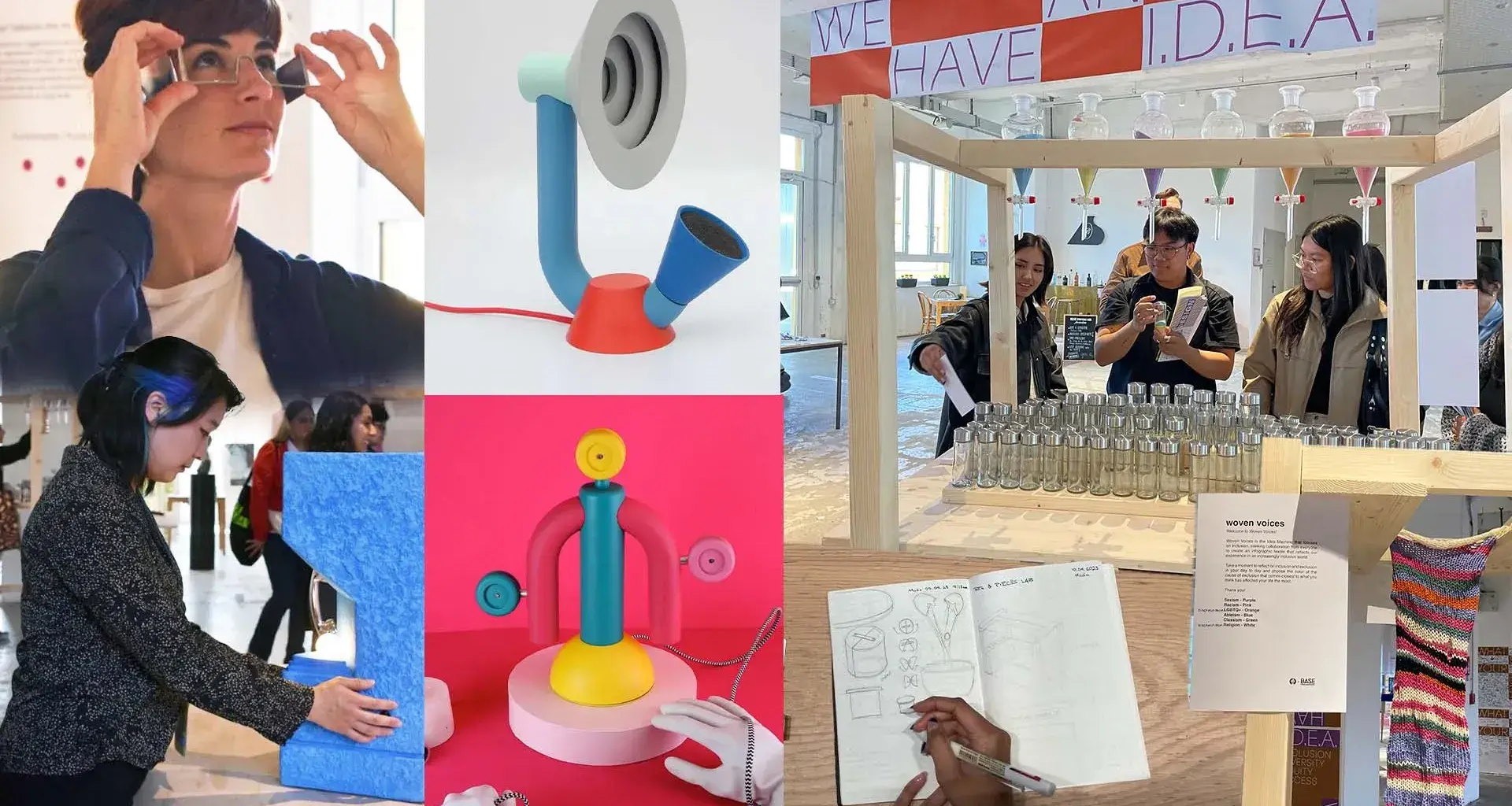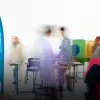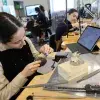2 groups of Tec de Monterrey students created machines for collective art on inclusion, diversity, equity, and accessibility, as well as items exploring offices of the future, which were presented at Milan Design Week 2023.
The first group of 4 students from the School of Architecture, Art, and Design (EAAD) participated in the We have an I.D.E.A. project after a 3-week stay in Milan.
The second, made up of 30 students from 8 campuses, exhibited the Office Futures collection that was produced in Jorge Diego Etienne’s international design class at the Tec.
Both projects were developed through BASE Milano, an international training and learning laboratory and research and experimentation incubator with which the Tec has a partnership.
“We want Tec de Monterrey’s School of Architecture, Art, and Design to always be present at the best design events, and the world’s most important event is Milan Design Week,” said Jorge Diego Etienne, National Director of Design at the EAAD.
Analog machines for collective art
As part of an academic stay in Milan, 4 design students from the Mexico City and State of Mexico campuses participated in the We have an I.D.E.A. project, which stands for: Inclusion, Diversity, Equity, and Accessibility.
Based on these concepts, the students researched and created analog machines to record what the more than 70,000 visitors to Milan Design Week felt about I.D.E.A.
“The artifacts collect qualitative data or stories from visitors to gain a better understanding of how the global design community is dealing with (these issues) or what to say about these issues,” explained José de la O Campos, Director of EAAD’s Mexico City Region.
One machine was created for each concept and placed in different locations each day throughout Milan Design Week to generate random interaction.
The Inclusion artifact created a collective scarf from yarn selected by visitors. For example, the color red represented religious discrimination.
“We want Tec de Monterrey’s EAAD to always be present at the best design events.” - Jorge Diego Etienne
For Accessibility, people were invited to stick postcards to tell their stories, ultimately creating a mural. In Diversity, the design community could be defined through colored salts that had a specific meaning.
Finally, for Equity, a series of magnets with words was made to create a mural of words and photos.
The students participating in We have an I.D.E.A. were chosen for a 3-week stay at BASE Milano through a voting exercise at the Mexico City Region Design Department.
“During the semester, we looked for students with leadership, resilience, problem-solving, and self-management skills because the experience doesn’t just require talent,” explained José de la O Campos.
The students who took part in this exercise were:
- Alexis Adrián Valdés Zanatta
- Lorena Zayas de Vizcaya
- Lourdes Aguilar Espinal
- Fabian Eduardo Iniesta Espinosa
According to Lorena Zayas, the project was important to her because it focused on issues that she considers important to society. She said:
“It was very important because we were working with inclusion, diversity, equity, and accessibility, which are very sensitive and important issues. If we do our job well, we can encourage meaningful reflection from every visitor.”
The collective art resulting from the exhibition will be interpreted by BASE Milano with the aim of helping to understand how the design community experiences and feels these values.

Designing the future at Milan Design Week
The Office Futures project came about in the International Design class taught by Jorge Diego Etienne and Diego Garza to 30 students from 8 Tec campuses during their final semester.
Designs were selected from these students at the Mexico City, State of Mexico, Guadalajara, Monterrey, Puebla, Querétaro, and Toluca campuses.
They worked on these items over the semester through a speculative and critical design exercise.
“The idea is to be able to give them the experience of thinking about the future. We generally design for the present, but the idea was to respond to the possible future 10 to 15 years ahead,” explained Diego Etienne.
Students created objects based on 3 macro trends in the workplace: loyalty, wellbeing, and the post-COVID-19 pandemic era.
The result was different small objects and accessories (not furniture) that can accompany workers in the office.
“One of my goals as a teacher is to give students opportunities that I would have liked to have had.” - Jorge Diego Etienne
For example, Mr. Lonely is a desktop element that accompanies users with moving light and sound. “The idea is that people in the future will need stimulation or to simulate that they have a colleague because we’re working more and more remotely,” Etienne said.
Anywhere is a kind of portable work surface. “After COVID, people realized that they could work anywhere, but it could be halfway up a mountain if we take it to the extreme,” he said.
Another design is a horn with a loudspeaker that fulfills the need to stimulate learning on the job when you have free time.
There is also a telephone, an object that is no longer current but that can be used for company. You pick up the horn to speak.
“The designers included interactive technology and programmed their creations, which has been a huge success in Milan. We’ve received very positive comments and it has led to some incredible reflections. People see it being used in the present,” said the academic.
Learning in the design capital
Jorge Diego Etienne is proud to provide these opportunities to all the campuses where the Design Degree is taught.
“One of my goals as a teacher is to provide students with opportunities that I would have liked to have had because they change their design perspective. They develop the drive for all their projects to be of international quality,” he stressed.
It’s been an inspiring experience for Alexis Valdés, one of the Tec design students invited to the academic stay with BASE Milan and to Design Week. He said:
“Milan is full of collective art that is critical of the system, that sends suggestions to the authorities, which is inspiring.”
For her part, Lourdes Aguilar said that “Design is everywhere in Milan. It’s in a pizza ad and on street murals. They live and understand it differently to us, so we had to unlearn our methods and use new ones.”
For the Tec academics, these experiences develop and strengthen students’ soft skills, such as:
- International communication
- In-depth research
- Materials management abroad
- Self-directed learning
- Leadership
- Resilience
- Teamwork
They also learned to overcome many barriers so as to try not to be biased when creating.
In this regard, student Cristina Campos explained that having exhibited at Milan Design Week is an experience in which she acquired a global design perspective from outside of Mexico as a graduation candidate.
“I got to know brands and professional studios. I saw what students from universities around the world do. And now I can make decisions about what I want for my career in the future.”
Milan Design Week took place from April 17 to 23 in Milan, Italy.
YOU’LL ALSO WANT TO READ:





